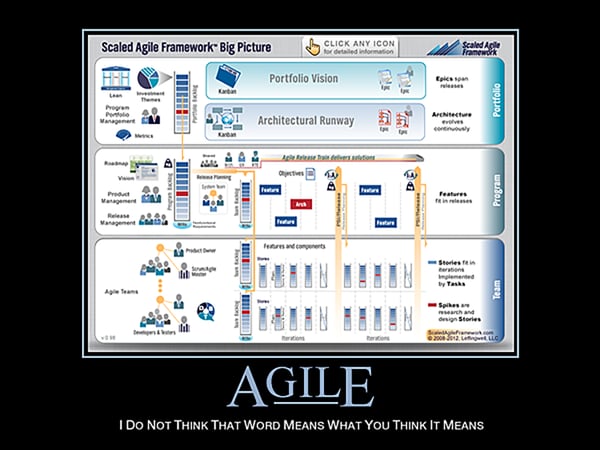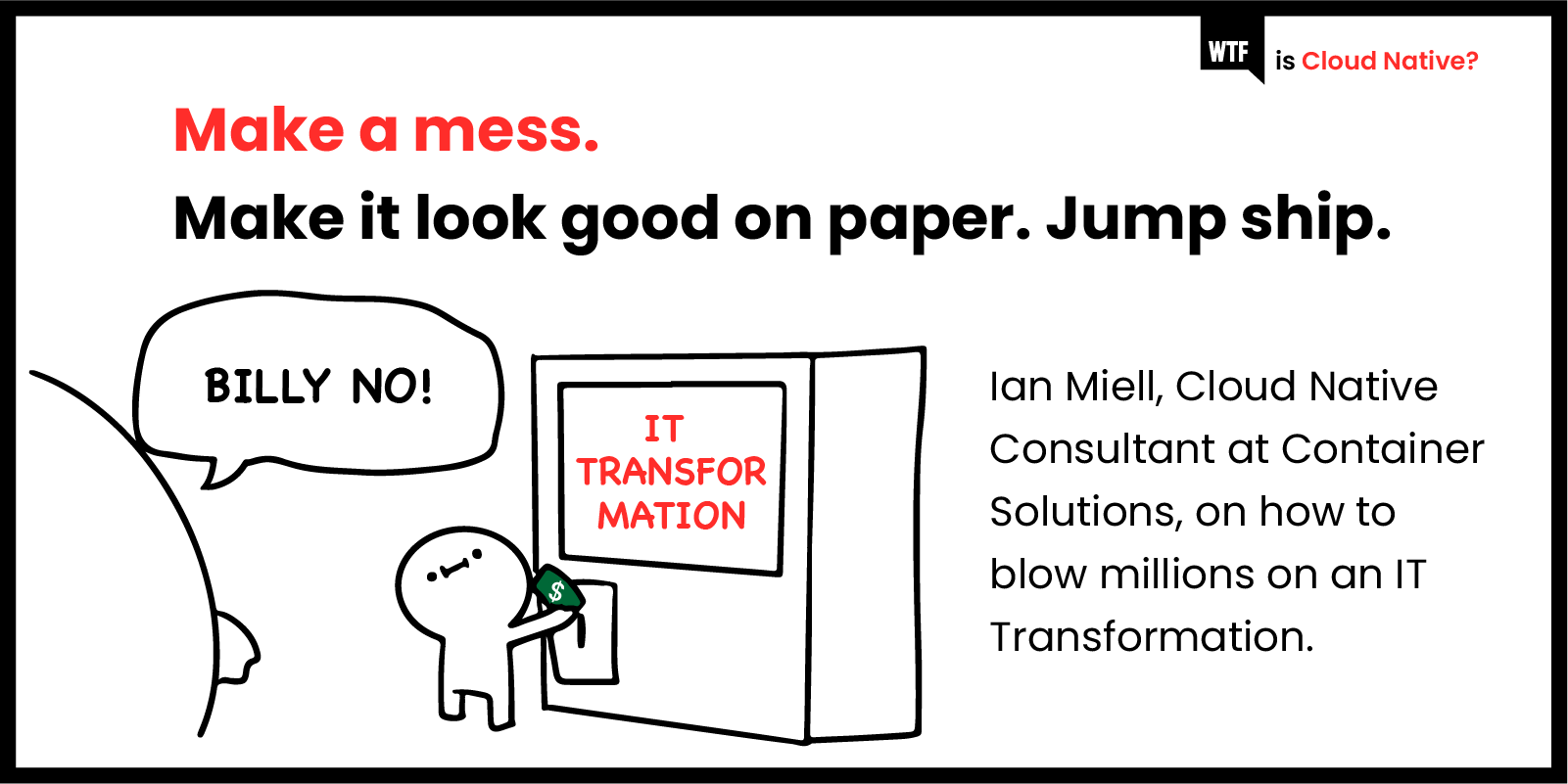You’re a few years into your tenure as CEO of Vandelay Industries, a behemoth in the transpondsting space that’s existed for many decades.
The real strategy
You could really use the share price to go up soon, so you can sell your shares at the optimal point before fortune’s wheel turns and the board inevitably gets rid of you.
You’re tired of Vandelay, and want to move to a better CEO job or maybe a nice juicy chairmanship of another behemoth board before the share price drops.
What happens to Vandelay after you’re gone is not your problem. In fact, as you are likely to go and work for a rival corporation, it might even be better if things were worse at Vandelay after you’ve sold your shares.
Any means necessary are on the table.
Fortunately the solution to this problem is simple:
Declare a major technology transformation!
Why? Wall Street will love it. They love macho “transformations”. By sheer executive fiat Things Will Change, for sure.
Throw in “technology” and it makes Wall Street puff up that little bit more.
The fact that virtually no analyst or serious buyer of stocks has the first idea of what’s involved in such a transformation is irrelevant. They will lap it up.
This is how capitalism works, and it indisputably results in the most efficient allocation of resources possible.
A dash of layoffs, a sprinkling of talent
These analysts and buyers will assume there will be reductions to employee headcount sooner rather than later, which of course will make the transformation go faster and beat a quick path to profit.
Hires of top “industry experts” who know the magic needed to get all this done, and who will be able to pass on their wisdom without friction to the eager staff that remain, will make this a sure thing.
In the end, of course, you don’t want to come out of this looking too bad, do you? So how best to minimise any fallout from this endeavour?
Leadership
The first thing you should do is sort out the leadership of this transformation.
Hire in a senior executive specifically for the purpose of making this transformation happen. Well, taking responsibility for it, at least. This will be useful later when you need a scapegoat for failure.
Ideally it will be someone with a long resume of similar transformational senior roles at different global enterprises.
Don’t be concerned with whether those previous roles actually resulted in any lasting change or business success; that’s not the point. The point is that they have a lot of experience with this kind of role, and will know how to be the patsy. Or you can get someone that has Dunning-Kruger syndrome so they can truly inhabit the role.
This is the kind of leader you want:
 Make sure this executive is adept at managing his (also hired-in) subordinates in a divide-and-conquer way, so their aims are never aligned, or multiply aligned in diverse directions in a four-dimensional ball of wool.
Make sure this executive is adept at managing his (also hired-in) subordinates in a divide-and-conquer way, so their aims are never aligned, or multiply aligned in diverse directions in a four-dimensional ball of wool.
Incentivise senior leadership to grow their teams rather than fulfil the overall goal of the program. (Ideally, the overall goal will never be clearly stated by anyone—see Strategy, below.)
Change your CIO halfway through the transformation. The resulting confusion and political changes of direction will ensure millions are lost as both teams and leadership chop and change positions.
With a bit of luck, there’ll be so little direction that the core business can be unaffected.
Strategy
This second one is easy enough. Don’t have a strategy. Then you can chop and change plans as you go without any kind of overall direction, ensuring (along with the leadership anarchy above) that nothing will ever get done.
Unfortunately, the world is not sympathetic to this reality, so you will have to pretend to have a strategy, at the very least. Make the core PowerPoint really dense and opaque. Include as many buzzwords as possible—if enough are included, people will assume you know what you are doing. It helps if the buzzwords directly contradict the content of the strategy documents.

It’s also essential that the strategy makes no mention of the “customer”, or whatever provides Vandelay’s revenue, or why the changes proposed make any difference to the business at all. That will help nicely reduce any sense of urgency to the whole process.
Try to make any stated strategy:
- Hopelessly optimistic (set ridiculous and arbitrary deadlines)
- Internally contradictory (such as, tight yearly budget cycles partnered with Agile development)
- Inflexible from the start (think “my way or the highway”)
Whatever strategy you pretend to pursue, be sure to make it “Go big, go early”, so you can waste as much money as fast as possible. Don’t fritter away precious time learning about how change can get done in your context. Remember, this needs to fail once you’re gone.
Technology architecture
First, set up a completely greenfield “Transformation Team” separate from your existing staff. Then, task them with solving every possible problem in your business at once. Throw in some that don’t exist yet too, if you like! Force them to coordinate tightly with every other team and fulfil all their wishes.
Ensure that your security and control functions are separated from (and, ideally, in some kind of war with) a Transformation Team that is siloed as far as possible from the mainstream of the business. This will create the perfect environment for expensive white elephants to be built that no-one will use.
All this taken together will ensure that the Transformation Team’s plans have as little chance of getting to production as possible. Don’t give security and control functions any responsibility or reward for delivery, just reward them for blocking change.
Ignore the “decagon of despair” (pictured below). These things have nothing to do with Transformation, they are just blockers people like to talk about. The official line is that hiring Talent (see below) will take care of those. It’s easy to exploit an organisation’s insecurity about its capabilities to downplay the importance of these things:

Talent
Hire hundreds of very expensive engineers and architects who don’t understand the business context. Do this before you’ve even established a clear architecture (which will never be defined) for your overall goals (which are never clearly articulated).
Give these employees no clear leadership, and encourage them to argue with each other (and everyone else, should they happen to come across them) about minor academic details of software development and delivery, thus ensuring that no actual delivery is in danger of happening.
Just let them get on with it:
![]()
Endgame
If all goes to plan, the initiative peaks at around 18 months in. The plan is in full swing and analysts are expecting benefits to show in the bottom line in the upcoming reports. Fortunately, you’ve done the groundwork, and internally, everyone can see it’s a mess.
People are starting to ask questions about the lack of results. The promised benefits have not arrived, and costs seem to be spiraling out of control. The faction for change you encouraged is now on the defensive in senior meetings, and the cultural immune system of the old guard is kicking in again, reasserting its control.
It’s now time for you to protest that everything is going to plan, but gracefully accept your fate and your juicy payoff. If you’ve still not got enough cash to be happy, then you can go to the rival Landervay Industries, and use your hard-won experience there to help turn that business around. Maybe this time it will work, as your main competition (Vandelay) seems to be struggling since you left…
Useful resources
- Generate a strategy statement without any effort
- Cloud Native Transformation patterns to avoid
Disclaimer
None of this happened in real life. Any relation to any enterprises or technology transformations existing or cancelled is entirely accidental.
A version of this post originally appeared on the blog zwischenzugs.



 Previous article
Previous article
